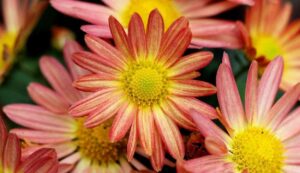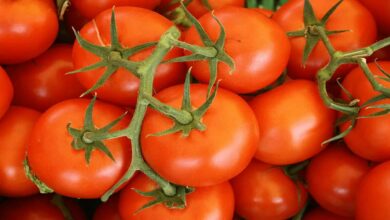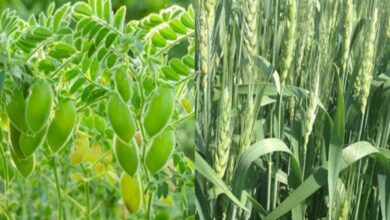Adopt these methods to protect chrysanthemum from diseases in winter; there will be high yield
Chrysanthemum Plant Diseases: Throughout North India, chrysanthemum flowers bloom throughout the winter, bringing a stunning array of colors to fields and gardens. However, the quality and quantity of chrysanthemum blooms may be greatly impacted by the circumstances that are conducive to a number of illnesses throughout the winter months. Understanding the infections and the wintertime environmental factors that contribute to their spread is crucial for successful disease management. The following are some of the main wintertime illnesses that North Indian chrysanthemums face, along with management techniques for them:

Symptoms of Powdery Mildew Disease
One of the most common fungal diseases in North India’s chilly, dry winters is powdery mildew disease, which is brought on by Oidium chrysanthemi. On the top leaf surface, it manifests as a white, powdery growth that eventually spreads to the stem and even the flowers. The plant may become weaker as a result of the affected leaves’ early curling, yellowing, and falling.
Management of Powdery Mildew Disease
Cultural Measures: To lessen moisture around the leaves, plant chrysanthemums in places with adequate air circulation. Air flow is also increased by pruning congested plants.
Steer clear of too much nitrogen: Too much fertilizer, particularly nitrogen-rich fertilizers, increases a plant’s vulnerability to powdery mildew.
Chemical Control: Powdery mildew may be effectively controlled using sulfur-based fungicides; however, they should not be used in severely hot or cold temperatures. To avoid resistance, rotate your fertilizers.
Disease Signs of Rust
During the chilly, wet winter months, rust is frequent and mostly caused by Puccinia chrysanthemi. On the top leaf surfaces, the illness first appears as tiny, yellow dots that develop into reddish-brown pustules on the underside. Leaf drop from severe rust infections lowers plant vigor and bloom production.
How to control rust disease?
Cultural precautions: Steer clear of overhead irrigation, which might disperse rust spores. Instead, irrigate the plants’ bases or utilize drip irrigation.
Sanitation: To lessen rust spore sources, routinely remove and destroy diseased leaves.
Chemical control: When infection symptoms first emerge, fungicides such mancozeb and chlorothalonil may be useful. Fungicides like triadimefon may be used for systemic control, but in order to avoid resistance, they should be used in conjunction with non-systemic fungicides.
Botrytis Blight (Grey Mold) Disease Symptoms
The fungus that causes botrytis blight, Botrytis cinerea, prefers chilly, moist winter weather, particularly when there is fog or high humidity. On leaves, stems, and flowers, the illness first manifests as water-soaked patches that eventually turn into a gray, fuzzy mold. The decay of infected blooms and buds may affect sales and aesthetic quality.
Management of Botrytis Blight (Grey Mold) Disease
Cultural Measures: To lower humidity, plant chrysanthemums in regions with good ventilation. To encourage air movement, steer clear of dense plants and trim or trim crowded foliage.
Sanitation: Since botrytis may survive on decomposing material, remove any diseased or dead plant matter right away.
Chemical Control: Fungicides that work against botrytis include boscalid and iprodione. Applying them proactively is crucial, particularly in high-risk situations like hazy mornings or after heavy rains.
Symptoms of Leaf Spot Disease
In the winter, fungi like Cercospora chrysanthemi and Septoria chrysanthemi often create leaf spots, which start out as tiny, dark brown to black dots that eventually get larger and cause the leaf to turn yellow and fall off. Wintertime low temperatures and high humidity are ideal for these mushrooms.
Management of leaf spot disease
Sanitation: To cut down on inoculum (pathogen) sources, remove diseased leaves.
Cultural Measures: Proper plant spacing lowers humidity and encourages air circulation.
Chemical Control: Throughout the season, use copper-based fungicides or protectant fungicides like mancozeb. To reduce resistance, systemic fungicides like thiophanate-methyl may be used in combination with non-systemic alternatives.
Symptoms of Downy Mildew Disease
Peronospora destructor, the causative agent of downy mildew disease, is more intermittent but may do significant harm during cold, wet winters. It manifests as purple-brown fungal growth underneath yellow dots on the top leaf surface. Infection with downy mildew results in plant growth retardation and leaf loss.
Managing Downy Mildew Disease
Cultural Measures: To decrease leaf wetness, avoid overhead watering and keep plants spaced properly. Plant in places that drain well.
Chemical control: Apply fungicides that work against downy mildew, including metalaxyl or fosetyl-al. Because rain raises the moisture content, frequent spraying is required, particularly after rain.
Disease of root and crown rot
The destructive disease known as “root and crown rot of chrysanthemum,” which is mostly brought on by the soil-borne pathogen Phytophthora cryptogea and sometimes by other species of Pythium, has a major impact on chrysanthemum output. Wilting, leaf yellowing, and browning of the stems near the soil line are typical symptoms. Stunted plant development and, in extreme situations, plant death are the results.
Signs of the Disease of Root and Crown Rot
1. Early signs include leaf withering and yellowing, particularly on the lower leaves.
2. Crown rot: Dark, sunken spots close to the soil line at the base of the stem.
3. Root rot: When the root system deteriorates and becomes brown, the roots become pulpy and lose their capacity to absorb nutrients.
4. Stunted development: Because of inadequate nutrient and water absorption, affected plants exhibit stunted growth.
Managing Crown and Root Rot
1. Cultural Actions
Proper drainage: Since these pathogens like saturated soil, make sure the soil drains well to avoid waterlogging.
Hygiene: To keep infections out, clean trays, pots, and equipment before using them.
Prevent overwatering: To avoid too damp soil, follow a correct watering schedule.
In order to lower the number of soil-borne diseases, soil solarization entails covering the soil with transparent plastic during hot weather. Make use of planting materials free of disease: To avoid early infection, start with seeds or cuttings free of pathogens.
2. Control by biology
Resistant microorganisms: By directly or indirectly preventing the development of Phytophthora and Pythium, beneficial organisms like Trichoderma harzianum and Bacillus subtilis may be used as soil sprays to reduce the number of pathogens.
Mycorrhizae: Plant roots’ tolerance to infections and overall health may be improved by arbuscular mycorrhizal fungus (AMF).
3. Control of chemicals
Fungicides: Applying fungicides as soil sprays, such metalaxyl, might be beneficial. To avoid resistance development, it is crucial to adhere to the suggested dose and application schedule.
The majority of winter chrysanthemum illnesses are managed by integrated disease management (IDM).
In order to successfully control several illnesses in chrysanthemum production over the winter, integrated disease management, or IDM, is crucial. IDM integrates biological, chemical, and cultural methods to manage illness in a sustainable way, including
Frequent monitoring: Examine plants often to spot disease signs early and take prompt action.
Optimal spacing and pruning: To increase air circulation and reduce moisture buildup on leaves, keep plants at the right distance from one another and trim any thick foliage.
Use of biocontrol agents: Use biocontrol agents that may help reduce soil-borne diseases and enhance plant health, such as Trichoderma or Pseudomonas fluorescens.
Fungicide use: Apply fungicides sparingly, according to dosage recommendations and intervals between sprays. To postpone resistance, it’s critical to use fungicides with several modes of action.
Temperature and moisture control: Keep an eye on the weather, particularly in the winter. Watering late in the day will prevent the leaves from being damp overnight.





